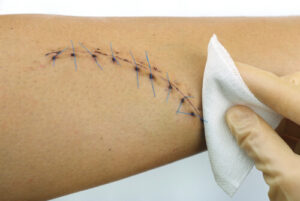Throbbing Pain After Stitches: Causes and Remedies
Surgical procedures and minor injuries often require stitches, ensuring the body heals properly and efficiently. However, many individuals confront a new challenge after the procedure – throbbing pain after stitches. What could be the underlying reasons for this discomfort? And, more importantly, how can it be effectively managed?
Journey with us as we unravel this often-debated topic, shedding light on the causes and remedies to help those in need.
Is throbbing normal after stitches?

Indeed, one normally experiences aching on the operated spot immediately after the needles and cotton. This is a normal reaction for the body after injury, and it is all part of the normal healing process. This is usually due to extra blood flow in the region and the repair work courtesy of the body’s inflammatory reaction.
It is normal to feel pain or discomfort after being stitched. Still, suppose that pain grows into a severe ache. In that case, he should consult a good surgeon or specialist doctor to ensure that everything healed appropriately without post-surgical complications.
Causes of stitches pain
When an individual undergoes a surgical procedure or sustains a deep wound, stitches are often utilized to aid healing and bring the wound’s edges together. However, experiencing stitches pain is the most common cause of concern for many patients post-surgery or injury. Let’s delve deeper into the potential causes of this discomfort:
- Healing Process: As the body works diligently to heal the wound, natural inflammatory responses can result in pain around the wound. Swelling, redness, and warmth are the body’s ways of rushing nutrients and blood to the affected area.
- Surgical Site Infections: An infection is one of the most common causes of pain around stitches. Bacteria entering the surgical site can lead to infected stitches or even a more widespread infected wound. Signs to watch out for include oozing pus, increasing redness, and fever. It’s paramount to keep the stitches clean and avoid getting stitches wet unnecessarily to prevent infection.
- Nerve Damage: Sometimes, the surgical procedure or the injury itself may cause damage to the nerves in the area. This can result in a painful sensation or numbness in the injured area.
- Improper Care: Not cleaning the wound properly or applying antibiotic ointment as a healthcare professional recommends can contribute to stitches’ pain. Furthermore, using harsh chemicals instead of mild soap and warm water can irritate the skin around the stitches.
- Physical Activity: Engaging in contact sports or any activity that strains the surgical site before it’s fully healed can exacerbate pain. It’s essential to follow the guidance of healthcare providers regarding physical therapy and activity levels post-surgery.
- Suture Removal: Sometimes, the pain can be attributed to the stitches themselves, especially if they are too tight or if there’s a reaction to the suture material. Pain might also occur during suture removal, especially if the skin has started to heal over the stitches.
Suppose you or someone you know is experiencing severe stitches, pain, or any of the following symptoms, such as fever, swollen area, leaking blood, or red streaks emanating from the edges of the wound. In that case, contacting a doctor or healthcare provider is imperative. From prescription medications to additional medical treatment, proper treatment options can provide relief and ensure a safe and effective healing journey.
Symptoms of infected stitches
Stitches, often applied after a surgical procedure or to close a deep wound, play a pivotal role in wound healing. However, like any other body part, the surgical site where stitches are placed is susceptible to infections. Recognizing the symptoms of infected wounds and stitches is crucial to ensure timely medical treatment and prevent severe complications. Let’s explore the indicators that may suggest an infection:
- Redness: While a slight reddish hue around the wound is normal during the initial healing phase, persistent or increasing redness, especially if it spreads outwards from the stitches, is a common sign of infection.
- Swelling: The affected area might become noticeably swollen or puffy, which can be attributed to the body’s inflammatory response to bacteria at the surgical site.
- Oozing Pus: One of the most discernible signs of infected stitches is the presence of pus. This thick, often yellowish or greenish fluid indicates a bacterial infection and might emanate from the stitched area.
- Fever: An elevated body temperature or fever is a systemic sign that the body is fighting an infection. If you experience a fever in conjunction with other symptoms, it’s essential to consult a healthcare professional immediately.
- Pain: While some pain or discomfort is expected after getting stitches, an intense, throbbing, or increasing pain can be a red flag, pointing towards infected stitches.
- Warmth: If the skin surrounding the stitches feels unusually warm to the touch, it might be an indicator of an underlying infection.
- Odor: A foul or unusual smell from the wound is another potential sign that the stitches are infected.
If you notice any of the above symptoms or have concerns about your skin or stitches, it’s paramount to seek advice from a healthcare provider or doctor. Early detection and intervention can prevent severe infection and ensure a smoother healing process.
Medical treatment options for infected stitches

Infected stitches, while concerning, are a condition that medical professionals are trained to manage and treat. When stitches, often applied to close a surgical site or deep wound, become infected, doctors say it’s imperative to address the issue promptly to prevent complications and promote optimal wound healing.
Fortunately, different medical treatments are available for such cases. Here’s a closer look at some of the recommended treatments:
- Antibiotic Ointment: Antibiotic ointment is one of the first treatments for minor infections. The ointment directly acts upon the bacteria, instigating the causation of the infection to avoid its progression.
- Oral Antibiotics: In cases where the infection is more severe or is spreading, healthcare professionals might prescribe oral antibiotics. These systemic medications help in combating the bacterial invasion throughout the body.
- Warm Water Compresses: Warm compresses can relieve pain and swelling in the infected area. The warmth also aids in promoting blood flow to the region, which can expedite the healing process.
- Stitch Removal: In some situations, especially if the infection is localized around the stitches, a doctor or healthcare provider might remove the stitches prematurely to treat the underlying infection better.
- Drainage of Abscess: If pus accumulates beneath the skin, forming an abscess, a surgical procedure might be needed to drain it. This alleviates the pain and removes a significant source of the infection.
- Regular Cleaning: Keeping the stitches clean with mild soap and water, followed by applying a nonstick gauze, can prevent further bacterial accumulation and facilitate the healing of the infected wound.
- Follow-Up Appointments: Monitoring the infection’s progression and the treatment’s effectiveness is vital. Regular check-ins with the healthcare professional or doctor ensure the treatment is on the right track and adjustments can be made if necessary.
In summary, if you suspect that your stitches are infected, it’s essential to seek medical advice immediately. Early detection and treatment can prevent potential complications and support the body’s natural healing journey.
How to stop the throbbing pain after stitches
After undergoing a surgical procedure or receiving stitches due to a deep wound, it’s not uncommon for patients to experience throbbing pain around the affected area. This discomfort can be unsettling, but there are several strategies to alleviate the sensation of pain and promote a smoother healing process. If you’re grappling with this type of pain, consider the following measures to find relief:
- Cold Compress: Applying a cold compress to the stitched area can help reduce swelling and numb the pain. Ensure the compress isn’t directly on the skin; wrap it in a cloth to prevent frostbite.
- Pain Relievers: Over-the-counter pain medications can be taken to manage the pain, such as ibuprofen or acetaminophen. Following the recommended dosage and consult a healthcare professional if you’re unsure is essential.
- Elevation: If the stitches are on a limb, elevating the injured area can help decrease swelling, which, in turn, can reduce pain. This is especially effective for stitches on the hands or feet.
- Avoid Strenuous Activities: Refrain from engaging in activities that might strain the stitched area. For instance, avoid running or other intense physical activities if you have stitches on your leg.
- Loose Clothing: Wear loose-fitting clothing around the stitched area to prevent irritation. Tight clothing can cause additional discomfort by putting pressure on the wound.
- Follow Doctor’s Instructions: Adhering to the aftercare instructions provided by your healthcare provider is crucial. This may include guidelines on cleaning the wound or applying antibiotic ointment.
- Seek Medical Advice: If the throbbing pain becomes intolerable, persists, or is accompanied by other symptoms like excessive redness, swelling, or discharge, it’s essential to seek medical advice promptly.
In conclusion, while throbbing pain after stitches can be distressing, various methods can help manage and reduce the discomfort. Always prioritize your well-being, and don’t hesitate to contact a healthcare professional if you’re concerned about the healing or scar over the process.
When to visit the doctor
Stitches typically result in discomfort, whether due to surgery or an injury. However, while mild tenderness is normal, certain symptoms and types of pain can indicate surgery complications requiring immediate medical attention. If you’re navigating the healing process with stitches, it’s crucial to recognize when the discomfort might be a cause for concern. Here are several scenarios where visiting a doctor becomes imperative:
- Persistent or Intensifying Pain: If the pain around the stitched area doesn’t subside or worsen over time, it could signify underlying issues such as an infection or nerve damage.
- Signs of Infection: Redness, swelling, warmth, and oozing pus from the stitches indicate a potential infection. Additionally, if you develop a fever or experience red streaks extending from the wound, these are critical signs warrant a doctor’s examination.
- Unusual Bleeding: While minimal bleeding immediately after the procedure is expected, continuous or recurrent bleeding from the stitches needs medical evaluation.
- Stitches Coming Undone: If the stitches start to come loose or break before the prescribed removal date, it’s essential to have a doctor inspect the wound to prevent complications.
- Numbness or Tingling: Any numbness, tingling, or lack of sensation around the stitched area might indicate nerve involvement and should be assessed by a healthcare professional.
- Swollen or Bulging Wound: If the area around the stitches becomes noticeably swollen or bulges out, especially if accompanied by pain, it’s a sign that immediate medical intervention is needed.
While discomfort is a natural part of the healing process after receiving stitches, it’s crucial to stay vigilant. Understanding the symptoms that signify complications can ensure timely intervention, preventing further issues and promoting a swift and safe recovery.
Conclusion
In wrapping up, managing post-procedure discomfort is vital for a smooth recovery. The sensation of throbbing pain after stitches can be common for many, but understanding its causes and effective remedies can make the healing journey more bearable. Always stay informed and proactive in your care, and remember to consult a healthcare professional if the pain persists or any complications arise. Proper care and attention can ensure that your incision and stitches serve their purpose and lead to a successful healing outcome.
References
Infected Stitches: Symptoms, Treatment, and Prevention
https://www.medicalnewstoday.com/articles/infected-stitches
Pain in Stitches: When You Should See Your Doctor
https://www.lybrate.com/topic/pain-in-stiches-when-you-should-see-your-doctor/9a06bda56bdc41ba980cd4742d123c50
Infected Stitches: What to Look For and When to See a Doctor
https://www.healthline.com/health/infected-stitches
Surgical Incision Healing: What You Need to Know
https://www.webmd.com/first-aid/surgical-incision-healing
How Should I Care for My Stitches?
https://www.nhs.uk/common-health-questions/accidents-first-aid-and-treatments/how-should-i-care-for-my-stitches/

